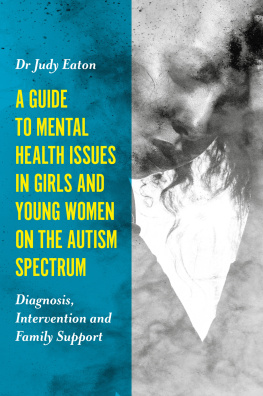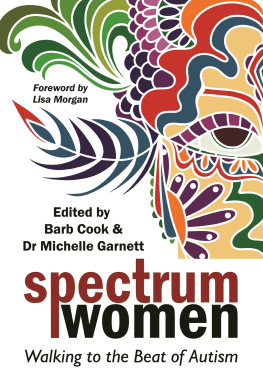Women and Girls with Autism Spectrum Disorder
by the same author
The Adolescent and Adult Neuro-diversity Handbook
Asperger Syndrome, ADHD, Dyslexia, Dyspraxia and Related Conditions
Sarah Hendrickx with Claire Salter
ISBN 978 1 84310 980 8
eISBN 978 0 85700 220 4
Love, Sex and Long-term Relationships
What People with Asperger Syndrome Really Really Want
Sarah Hendrickx
Foreword by Stephen M. Shore
ISBN 978 1 84310 605 0
eISBN 978 1 84642 764 0
Asperger Syndrome and Employment
What People with Asperger Syndrome Really Really Want
Sarah Hendrickx
ISBN 978 1 84310 677 7
eISBN 978 1 84642 879 1
Asperger Syndrome A Love Story
Sarah Hendrickx and Keith Newton
Foreword by Tony Attwood
ISBN 978 1 84310 540 4
eISBN 978 1 84642 662 9
Asperger Syndrome and Alcohol
Drinking to Cope?
Matthew Tinsley and Sarah Hendrickx
Foreword by Temple Grandin
ISBN 978 1 84310 609 8
eISBN 978 1 84642 814 2
of related interest
Aspergirls
Empowering Females with Asperger Syndrome
Rudy Simone
Foreword by Liane Holliday Willey
ISBN 978 1 84905 826 1
eISBN 978 0 85700 289 1

Sarah Hendrickx
Foreword by Dr Judith Gould

Jessica Kingsley Publishers
London and Philadelphia
First published in 2015
by Jessica Kingsley Publishers
73 Collier Street
London N1 9BE, UK
and
400 Market Street, Suite 400
Philadelphia, PA 19106, USA
www.jkp.com
Copyright Sarah Hendrickx 2015
Foreword copyright Judith Gould 2015
All rights reserved. No part of this publication may be reproduced in any material form (including photocopying or storing it in any medium by electronic means and whether or not transiently or incidentally to some other use of this publication) without the written permission of the copyright owner except in accordance with the provisions of the Copyright, Designs and Patents Act 1988 or under the terms of a licence issued by the Copyright Licensing Agency Ltd, Saffron House, 610 Kirby Street, London EC1N 8TS. Applications for the copyright owners written permission to reproduce any part of this publication should be addressed to the publisher.
Warning: The doing of an unauthorised act in relation to a copyright work may result in both a civil claim for damages and criminal prosecution.
Library of Congress Cataloging in Publication Data
A CIP catalog record for this book is available from the Library of Congress
British Library Cataloguing in Publication Data
A CIP catalogue record for this book is available from the British Library
ISBN 978 1 84905 547 5
eISBN 978 0 85700 982 1

Contents
Foreword
DR JUDITH GOULD
Historically there has been an assumption that autism is predominantly a male condition.
The female pattern of behaviour in classic autism was clear in those who were intellectually disabled but the girls and women who were more verbal and intellectually able were missed. It is only in recent years that we have begun to recognise the female presentation of behaviours in the autism spectrum and there are now many books written on this subject, usually by women on the spectrum. This book adds to our knowledge by providing an insightful, sensitive analysis of the pattern of behaviours in females from childhood through to old age.
The author poses the question Why did I write the book? She, like so many other women, has experienced the disbelief of professionals who have a narrow, stereotyped view of the male pattern of behaviour. She questions that autism is diagnosed on behaviour patterns when these are often different in women. The way forward is not that we need a new set of diagnostic criteria but a better understanding of how the behaviours are manifested in women. A book such as this is a useful resource in understanding the complexities of the female presentation of the condition.
This book combines existing research and knowledge on the subject, backed up with the personal experiences of women with autism and the families of girls with autism. Throughout, the examples given provide invaluable insights into the way the women and girls think.
The review of research sets the scene and the conclusion is that autism is more diverse than originally thought, with new ideas being put forward every day. In fact, its a case of the more we know, the less we know, particularly in how gender affects individuals with autism. Overall, there is little research differentiating the male/female profile. We are yet to establish an accurate estimate of the prevalence of the male:female ratio. If women are not being diagnosed then we cannot reliably say what the ratio is likely to be. Getting a diagnosis is covered in this book, which clearly sets out the difficulties experienced by the women and girls.
An added problem is that most current diagnostic assessments do not consider sex differences and only give examples of the male profile of behaviour. The knowledge and experience of an enlightened clinician are essential in both asking the right questions and interpreting the data to provide an accurate outcome.
The remaining chapters cover all aspects of life from childhood through to adolescence and adulthood. Each stage in a womans life brings new problems and dilemmas. The experiences described by those who participated in the authors research demonstrate how the girls and women had a rotten time in their school years through a lack of diagnosis and appropriate understanding and support.
Developing appropriate approaches will maximise the positive and minimise the negative elements of the womens journey through life.
The question is posed as to the value of a diagnosis in adulthood. Women often shared the same sense of relief and self-acceptance as men but to an even greater degree. The diagnosis provided an explanation of the problems they had experienced throughout their lives and now they could be themselves without hiding their problems. The descriptions throughout the book demonstrate the extraordinary resilience shown by these women, particularly in their compensatory strategies. These efforts often come at a price; exhaustion, breakdown and mental health issues are commonly mentioned by these women. It cannot be stressed enough that the ill-effects are the consequence of living with autism, not the conditions or symptoms, which may be considered in isolation. This is a very important point for clinicians.
Throughout the book, all phases of life are touched on and the message is that life is hard for everyone, particularly in regard to personal relationships, sexuality, gender identity, pregnancy and parenting, health and well-being and employment, but is even harder for those on the autism spectrum. The chapters on these aspects of life are encouraging, giving useful tips and reflecting that we can all be different and that this is to be celebrated.
The chapter Ageing with Autism is important as there are many women in their later years who have only recently received a diagnosis. It is important to say that it is never too late to gain an understanding of your life. In the final chapter, the most relevant quote is: The first step is for professionals to understand that the profile shows itself differently in females than males. You have to work a bit harder to find it, but its there. And just because its not too visible, doesnt mean its not severe.
Next page














